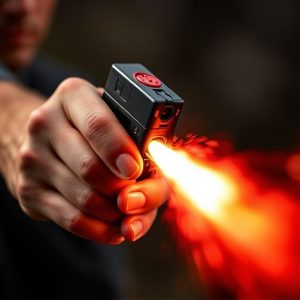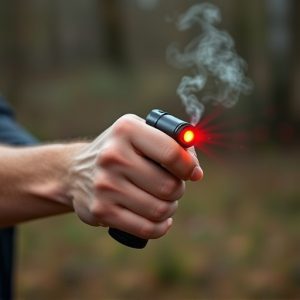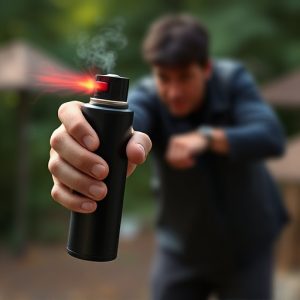Pepper Spray Tactics: Maximize Effectiveness, Minimize Risks with Wind Direction Tips
Strategic deployment of pepper spray, aiming into the wind, enhances its effectiveness in law enforc…….
Strategic deployment of pepper spray, aiming into the wind, enhances its effectiveness in law enforcement scenarios by creating a barrier that controls subjects' movement and lingers longer. Understanding wind direction is crucial for officers to prevent blowback, mitigate risks, and ensure safer operations while using pepper spray as a controlled tool for crowd control and subject incapacitation. Following Pepper Spray Wind Direction Tips prioritizes tactical decision-making, safety, and minimizing collateral damage.
“Uncovering the power of pepper spray as a critical tool in law enforcement, this article delves into its strategic deployment. From understanding the science behind its effectiveness to navigating safety precautions, we explore how officers can maximize its impact. Learn about the optimal Pepper Spray Wind Direction Tips for precise and safe use. Discover strategies to ensure effective deterrence while minimizing risks, making it an indispensable asset in modern policing.”
- Understanding Pepper Spray as a Law Enforcement Tool
- The Science Behind Pepper Spray's Effectiveness
- Strategies for Effective Pepper Spray Deployment
- Safety Precautions and Wind Direction Tips for Officers
Understanding Pepper Spray as a Law Enforcement Tool
Pepper spray, officially known as oleoresin capsicum (OC) spray, is a powerful law enforcement tool designed to incapacitate individuals temporarily while ensuring officer safety. Understanding how this weapon works and its unique characteristics is crucial for effective deployment. One critical aspect often overlooked is the pepper spray wind direction tips. Proper usage involves considering the breeze or wind, as it can significantly impact the spray’s effectiveness and range. When applying pepper spray, officers should aim to create a barrier between themselves and the subject by directing the stream into the wind. This simple technique allows for better control of the spray’s dispersion, ensuring it lingers in the target area longer, thereby maximizing its incapacitating effect.
By understanding these pepper spray wind direction tips, law enforcement can enhance their tactical approach, especially in dynamic situations where quick and precise control is essential. It’s a subtle yet vital consideration that can make all the difference in managing potential threats effectively while minimizing harm to both officers and suspects.
The Science Behind Pepper Spray's Effectiveness
Pepper spray, a powerful tool in law enforcement, relies on capsaicin, the active ingredient found in chili peppers, to disrupt an individual’s vision and respiratory system temporarily. When deployed, pepper spray creates a cloud of fine droplets that, when inhaled or making contact with the eyes, causes intense irritation and discomfort. Understanding the science behind its effectiveness is crucial for both law enforcement officers and individuals looking to protect themselves, especially when considering pepper spray wind direction tips.
The wind plays a significant role in pepper spray’s performance. In optimal conditions, a gentle breeze can help disperse the spray evenly, increasing its coverage area and reducing direct exposure. However, strong winds or unpredictable air currents might cause the spray to blow back onto the user or disperse too quickly, limiting its effectiveness. Pepper spray wind direction tips often emphasize the importance of considering atmospheric conditions to maximize the tool’s impact while minimizing risks.
Strategies for Effective Pepper Spray Deployment
When employing pepper spray, understanding wind direction tips is crucial for effective deployment and minimizing collateral damage. The key strategy lies in ensuring the target area is upwind from where the spray is released. This prevents the spray from blowing back onto the user or bystanders, maximizing its impact on the intended subject. By accounting for wind patterns, law enforcement officers can enhance safety and control during volatile situations.
Additionally, training in pepper spray application techniques is essential. Officers should practice different scenarios, including how to aim, activate, and move away from the spray cloud to ensure optimal coverage while minimizing exposure. These strategies, combined with proper wind direction considerations, empower law enforcement to use pepper spray as a powerful tool for crowd control and subject incapacitation in diverse environments.
Safety Precautions and Wind Direction Tips for Officers
When deploying pepper spray, law enforcement officers must prioritize safety and be mindful of wind direction to maximize effectiveness and minimize risks. It’s crucial to scan the area for any potential hazards or individuals with medical conditions that could be affected by the spray. Officers should also ensure their own safety gear is properly fitted, including protective eyewear, as pepper spray can cause eye irritation.
Wind direction plays a significant role in the accuracy and reach of pepper spray. To maximize coverage, officers should deploy the spray into the wind, allowing it to drift towards the target area. Conversely, when facing an incoming breeze, they should aim slightly upwind to prevent the spray from blowing back towards them or their colleagues. These Pepper Spray Wind Direction Tips are essential for tactical decision-making during operations to ensure optimal control and minimize collateral damage.
Pepper spray, when deployed strategically, can be a powerful tool in law enforcement. Understanding its science-backed effectiveness and learning safe deployment methods, along with considering pepper spray wind direction tips, empowers officers to make informed decisions in high-pressure situations. By adhering to safety precautions, professionals can ensure the optimal use of this force multiplier while minimizing risks.


